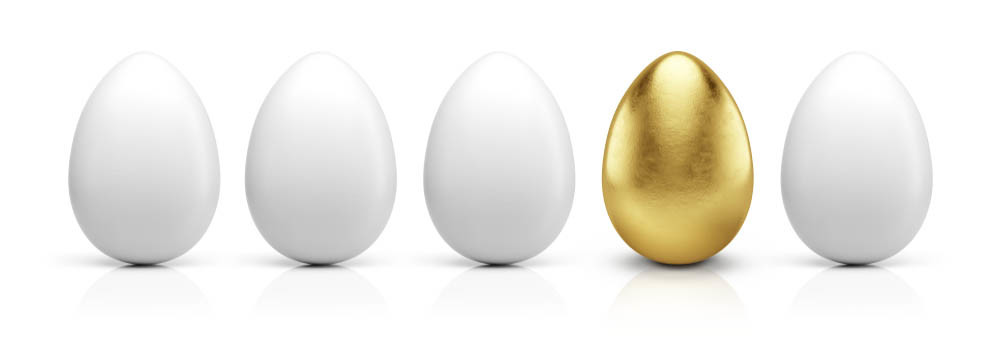This post is also available in: Español
The Antral Follicle Count is a swift indicator of fertility.

You make a golden egg every month. Your Antral Follicle Count indicates how well your ovaries are functioning.
Women with low Antral Follicle Count (AFC) are an ongoing problem for the medical community. There is confusion about what it means, and what the numbers represent. This article will clear that up, and help you understand the issues surrounding it. You will also understand what is needed to increase Antral Follicle Count for a successful pregnancy.
The Antral Follicle Count (AFC) is the measured number of growing eggs in your ovaries on day 2, 3 or 5 of your cycle. Women from 18 to 37 years will have on average 20 follicles per cycle. After 37 years the count decreases by 1 follicle per year until there are only 5 eggs growing per cycle at the age of 50. A woman at 37 has 25000 eggs and at 50 is expected to still have 1000 eggs left to grow. These are the statistics.
What the Antral Follicle Count actually means to a woman’s fertility is not well understood. Interpretations on the number of follicles in the count have created terms like diminished ovarian reserve, low ovarian reserve and, poor ovarian responder. These medical terms have created great confusion, so let’s clear them up.
Diminished Ovarian Reserve (DOR) and Low Ovarian Reserve (LOR).
These two terms mean the same thing. It is supposed to indicate a woman is running low in her ‘primordial follicle pool.’ Basically, a short supply of eggs to grow. An ultrasound will show less than the normal number of eggs growing in your ovaries during your cycle. Checking Antral Follicle Count numbers are supposed to be indicative of how many primordial follicles are left. They are not.
No test and no doctor can tell you how many primordial follicles, or eggs you have left.
It is important to understand that there is no test to measure the ‘primordial follicle pool.’ The actual numbers of eggs in ‘ovarian reserve’ have never been measured. The numbers used are based on mathematical extrapolations based on mice research. In short, there is no such thing as ‘diminished,’ or ‘low’ ovarian reserve, because they cannot measure it. What they can accurately say is diminished or low Antral Follicle Count. Assumptions are made about ovarian reserves based on the AFC.
Folliculogenesis (follicle formation).
Instead of using the inaccurate terms of diminished or low ovarian reserve, ‘under-performing folliculogenesis’ would be more accurate. The ability of your ovaries to turn primordial follicles in antral follicles is the problem, not how many you have left. If your ovaries are underperforming you will have lower than normal Antral Follicle Count. The less the ovaries perform, the lower the AFC. A 50-year-old woman has a natural Antral Follicle Count of 5 eggs per cycle. Science suggests she also has 1000 eggs, still left to grow. That is enough eggs for 200 more cycles or 16 years of ovulation! But we know that fertility declines at 37 with an AFC of 20 eggs per cycle and 25000 eggs remaining. At 46 natural fertility generally stops altogether. A 46 years old woman has an AFC of 11 eggs per cycle and well over 1000 eggs remaining.
Tests can see the AFC declining and have linked lower levels to decreasing fertility. If you have lower than normal AFC it is a sign that your ovaries are underperforming, natural fertility challenged and a swift sign something is wrong.
We now know the flaws in the concept of ovarian reserve, and that it really has no meaning.

The glaring omission of IVF
Doctors wish to increase Antral Follicle Count (AFC) in women with low numbers, to improve IVF success rates and pregnancies. Though doctors can increase it slightly with drugs, pregnancy rates are still very low. Why is this?
What your AFC really tells your doctor is how likely IVF drugs are to work.
To the IVF community, women with low AFC’s mean they will not respond well to the ovarian stimulating drugs used in an IVF cycle. This has created the term ‘poor ovarian responder,’ and this term is accurate.
IVF drugs do not work well on women with low Antral Follicle Count.
To understand why we need to know what is needed to grow your eggs in the first place. For a full article read here. In short Anti-Mullerian Hormone (AMH) begins the lifecycle of the follicle. Anti-Mullerain Hormone takes the primordial follicle and turns it into a primary and secondary follicle. Follicular Stimulating Hormone (FSH) takes over the secondary follicle and turns it into the fully developed and mature egg ready to be ovulated. Correct levels of AMH and FSH are the essence of folliculogenesis. Too low AMH and too high FSH disrupt egg growth and are the foundation of infertility for these women.
Women with low AFC tend not to mature eggs well. This reduces the ability for ovulated eggs to be fertilized.
Anti-Mullerian Hormones and Follicular Stimulating Hormones determine how well your ovaries can produce good quality, fertilizable eggs. AMH and FSH levels let doctors estimate how well IVF drugs could increase Antral Follicle Count and grow good eggs. Women with high FSH and low AMH levels respond poorly to IVF drugs. They have the smallest chance of success with IVF. To date, no IVF hormone therapy has been able to lower FSH levels or to raise AMH levels.
The success of IVF hinges on good quality eggs. Quality egg production hinges on good AMH and FSH levels.
Fix the hormone levels, fix the problem! Right? Umm…no.

To date, science has nothing to raise AMH levels or lower FSH levels. The 40-year-old focus of IVF applies to all women. IVF philosophy can read, “Grow as many eggs as possible, fertilize what you can, hope they fall pregnant.” Read the essential guide to IVF and Low AMH here.
IVF remains the number one treatment for women with low AMH and high FSH. The problem is that it works for so few.
The FSH trap
1981 heralded the importance of Follicular Stimulating Hormone (FSH) in fertility. FSH levels created markers for ovarian responses to IVF drugs. Women responding poorly to these drugs established the upper and lower limits of good FSH levels. These levels became the gold standard for predicting IVF outcomes. These values helped create dosage levels for the ovarian stimulating drugs of IVF.
Researchers knew the FSH test was far from perfect. It had to be done in the early follicular phase. Variations in Estrogen (E2) levels changed FSH interpretations. It also required the normal functioning of the hypothalamic-pituitary-gonadal system. FSH is a marker of low response to ovarian stimulation. However, only elevations above the norm carried significance. Moreover, high FSH levels are a known risk factor for ovarian hyperstimulation.
Because of these limitations, researchers pursued a more ideal test.
Research showed that as women’s FSH levels exceeded 20 IU/L, egg pick up and fertilization rates declined. Levels over 25 IU/L were still able to create viable eggs for transfer in women over 40. Even today, IVF birth rates with FSH over 20 IU/L are around 2%.
High FSH levels are terrible for egg quality and the effectiveness of IVF drugs. We also know that FSH injections are the beginning of every IVF treatment. If women already have high levels, and can’t produce a good egg, how can adding more FSH help? Yet this treatment is applied to all IVF patients, regardless of existing FSH levels.
AMH enters the arena
In 2002, AMH became the new marker of ovarian reserve. AMH took over from the FSH test because of superior accuracy. AMH levels now predicted the effect of IVF drugs on ovarian stimulation. Like FSH, response rates to IVF drugs created the good and bad AMH reference ranges. FSH values remained as a guideline but now less significant.
AMH testing created two new terms. ‘Diminished ovarian reserve’ is for women whose ovaries show less than five eggs in each ovary on a pre-IVF CT scan. ‘Poor ovarian responder’ is for women who do not grow more than five eggs with IVF drugs. A recent study showed that low AMH levels are more indicative of IVF outcomes when FSH is normal. It also showed that abnormal FSH levels have less impact on fertility than low AMH levels.
The benefits of AMH testing over FSH
- The AMH test can be done on any day.
- FSH levels are best tested on day 3 of a menstrual cycle.
- AMH levels tend to stay the same over subsequent tests.
- FSH values can vary dramatically cycle to cycle.
- The AMH test is a ‘stand-alone’ test.
- FSH needs other reference points to interpret its significance.
- AMH levels are predictable at different ages.
- FSH levels are unpredictable regardless of age.
The AMH/FSH balance
Good AMH levels are the foundation of growing a fertilizable egg. AMH begins the life cycle of your eggs. FSH takes over halfway and matures the egg, as AMH passes the baton. If AMH levels are low, FSH levels increase to try and help the egg grow.
Without enough AMH, FSH cannot mature an egg for fertilization.
FSH is excellent at finishing eggs; it needs a good foundation to work from. Think of AMH as Primary school and FSH as a secondary school. You can’t put your five-year-old in secondary school and expect them to be like the others. Likewise, your body can’t use high FSH levels to grow good eggs if AMH hasn’t helped first.
Sufficient AMH underpins the entire success of IVF treatment.
Current IVF methods do not address issues with low AMH levels. Doctors increase Antral Follicle Count by adding FSH to a woman’s body. Adding FSH to women with low AMH levels does not grow good eggs. Adding FSH to already high FSH levels doesn’t help either. The IVF drugs that have helped so many others, now falter and fail. In no way does any treatment in IVF address low AMH, or high FSH levels.
Improving low AMH levels will cause high FSH levels to reduce, but science has no treatment for it. It doesn’t even appear to be a field of research to broaden the effectiveness of IVF.
Not addressing AMH levels is a glaring omission. Medicine glosses over the problem, “nothing can really help anyway.” Women are still advised to rush into IVF with a ‘before it is too late’ warning. No gambler would put their money down on such a long shot, yet many hopeful mothers will.
In 40 years, IVF strategies have not changed. Improved discoveries in how fertility works have not prompted new treatments to address them. IVF remains the only recommended medical option for low AMH.
IVF strategies are unsuitable for women with low AMH and high FSH levels. Einstein said, “Repeating the same thing over and over again is the definition of insanity.” With high costs and meager success something, a change in strategy is needed.
Using Ovance and RPM to raise your AMH levels is an excellent way to increase Antral Follicle Count, increase AMH levels and lower FSH levels. Get your hormone levels back to normal with Ovance and RPM to solve the problem at the source. Fix your AMH and FSH levels before using IVF and your outcomes will improve.





